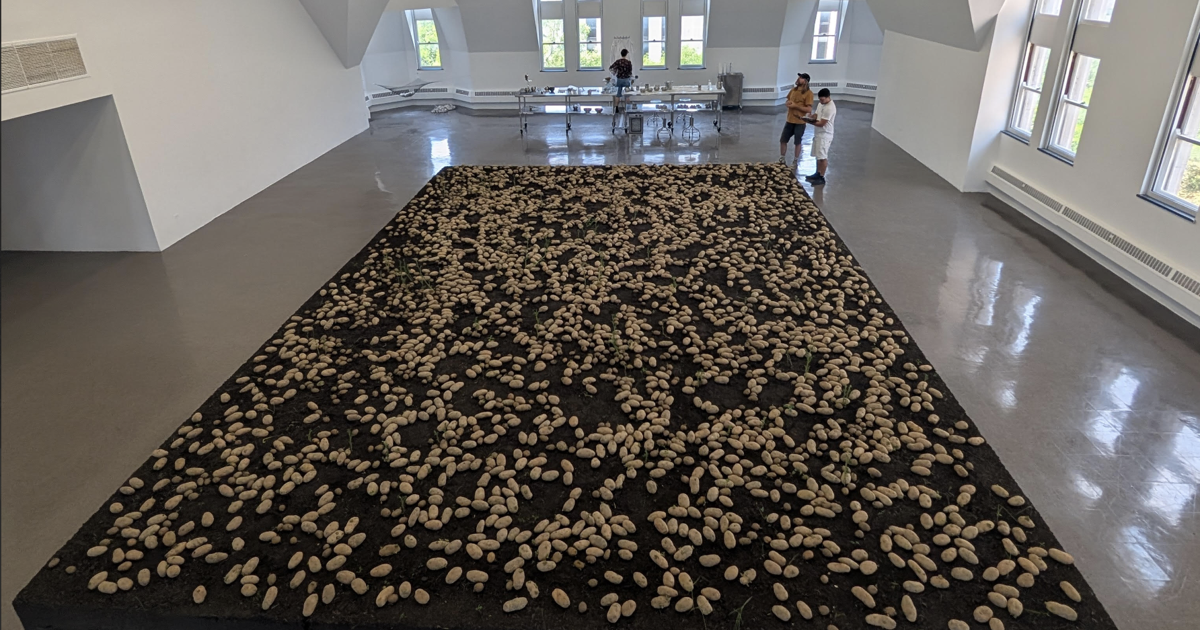The Renaissance Society’s new show, “Germinations,” by Lima-born artist Ximena Garrido-Lecca consists primarily of a large rectangle of compact earth covered in maybe four or five hundred potatoes. Some of them have sprouting green eyes, some have shrunk and others have issued new shoots.
To the right of the soil patch is a boiling pot, which contains one potato, along with a metal staircase and platform which one can ascend to view the potatoes from above. To the left of the soil patch is a work station where the gallery attendant utilizes various scientific measuring devices to measure potatoes and, inspired by indigenous practices in Peru, sculpt them into offerings.
Throughout the day, gallery attendants ferry one boiled potato from the pot to the work station, where they dehydrate it, mix it with plaster, let it dry and harden, and then place it on an elastic net, already weighed down with other similar offerings. The net distends in a manner that is meant to recall the way planets distend the fabric of space-time. More broadly, the exhibit is meant to bring into dialogue an Andean, indigenous way of knowing the world with modern, relativistic science. Attendees wear lab coats and utilize calipers in the process of shaping potato offerings that they present as gifts to “pachamama” (Mother Earth).
The gallery brochure notes that indigenous Andean communities had and have a cyclical conception of time at odds with the linear, unidirectional, clock-organized measure with which we are familiar. Some communities measured time using the “papacancha,”, a unit based on the amount of time it takes to boil a potato. The boiling potato pot is, I gather, a sort of clock whose purpose is to lead us to question our modern sense of mechanically delineated time. The circular shape of the observation tower is also meant to evoke the vanished cyclicality of indigenous time, according to the brochure.
Like many other works of contemporary, conceptual art, this one, then, places indigenous knowledge alongside Western or Enlightenment ways of experiencing the world. Whether to elevate indigenous knowledge, to dignify it by placing it alongside something (science) which is already dignified, or to denigrate Western knowledge is unresolved and left up to the viewer. Regardless, it seems open to questioning whether the exhibit is actually doing any of this epistemic questioning work or just saying, via the brochure, that that’s what it’s doing.
I for one did not feel the press of linear time any less in this exhibit.
Industrial time was beaten into the minds of the working masses over a period of 200 years by men wielding billy clubs and bayonets. The sight of potatoes placed incongruously inside of a gallery did not enable me to undo or question modern man’s violent psychological birthright. Walking up a circular staircase did not help me unwind my clock.
What I was able to do, as in many other galleries, was to gawp at something big which was brought from the outside world inside, somehow. There really is an enormous number of potatoes here, I thought, and an even larger amount of dirt.
Like other conceptual artists since Duchamp, Garrido-Lecca has taken advantage of the fact that galleries and museums are constituted so as to invite heightened attention on whatever is laid before the eye. This importing procure enables any object, whatever it may be, to imbibe the gallery atmosphere’s peculiar sacrality, and elicit the sort of experiences one associates with paintings and other obviously beautiful things, at least in theory.
But I find that as often as not I am drawn less to the thing itself and more to the fact of its dislocation, not the wonderful regenerative powers of potatoes or of potato-time, so much as the question of how so much soil was moved upstairs.
I asked the gallery attendant how all this came up here and she told me it was carted up in wheelbarrows. There is no freight elevator in the Cobb building, so all this enormous quantity of earth had to ride up cart by cart inside of the passenger elevators. After this, the soil was encased in wooden boards and compressed. Initially, the attendant said, the boiled potato offerings were made from mashed potatoes and shaped into little forms. Initially gallery visitors were encouraged to shape them however they liked. But the procedure was modified when the offerings attracted too many flies. The potatoes had to be mixed with plaster in order to last longer. They come from a separate, fresh, store bought bag, and not the soil heap.
Potatoes have come to shape the rhythm of her days, the attendant told me, determining when she has to make offerings, when she has to unload the pot, and when she can sit in the office. In this way it seemed that one person at least, had experienced the exhibition as it was intended to be experienced.
During this summer’s heatwave, the attendant added, the potatoes began to rot at an accelerated rate. The University of Chicago turned its HVAC off at night, and without the cooling, the exhibition began to stink. An agreement had to be worked out with facilities to keep the room air-conditioned in order to mitigate the rotten smell and the bugs. I asked if anyone had insisted on letting things rot and attract flies, and the attendant said that the artist had asked that the issue be mitigated, with air conditioning. This information struck me as more provocative than the exhibition itself.
“Germinations” is on view at the Renaissance Society, 5811 S. Ellis Ave., through July 13.
